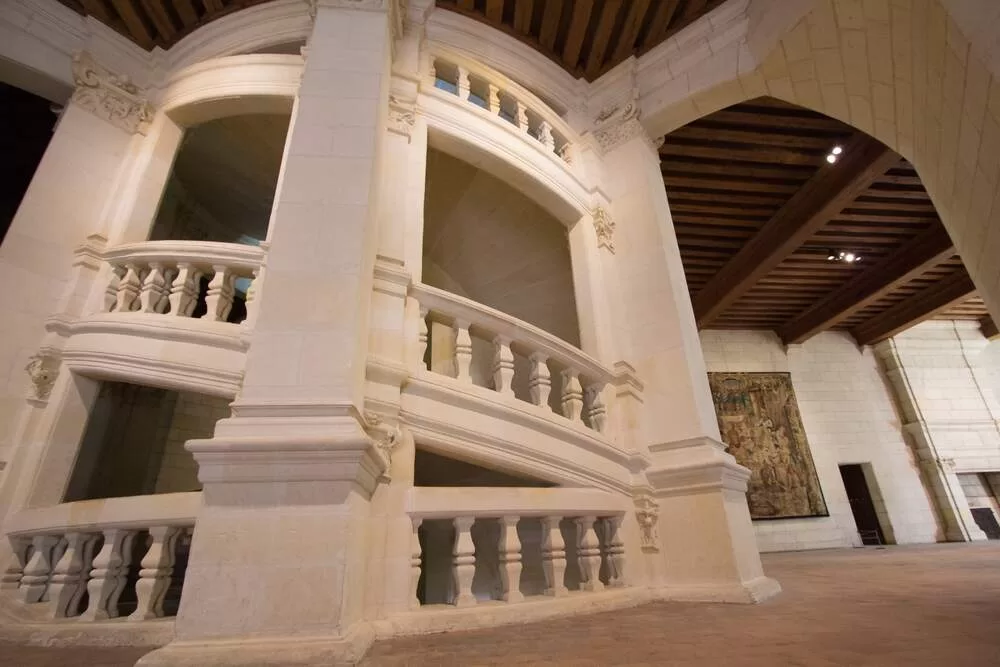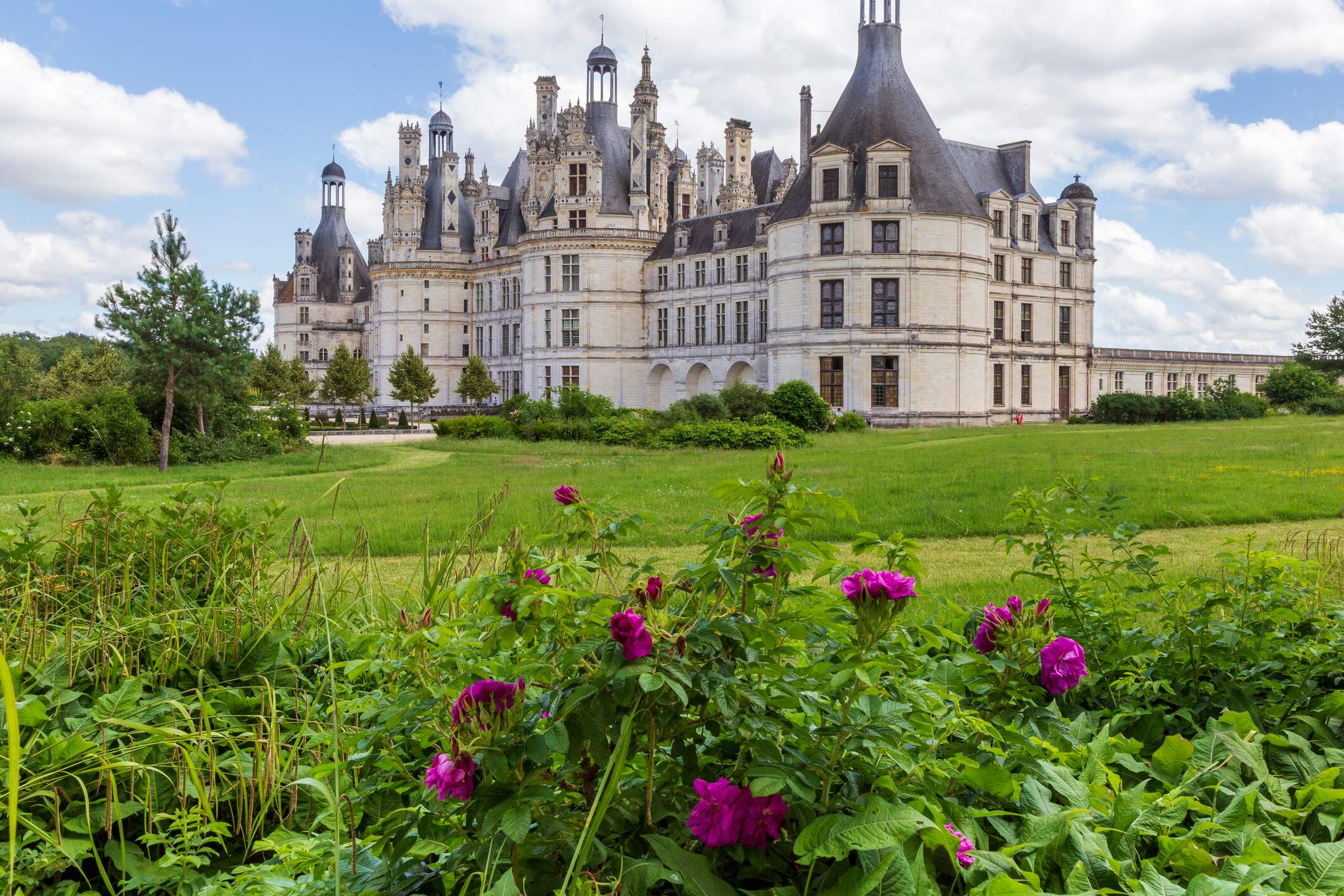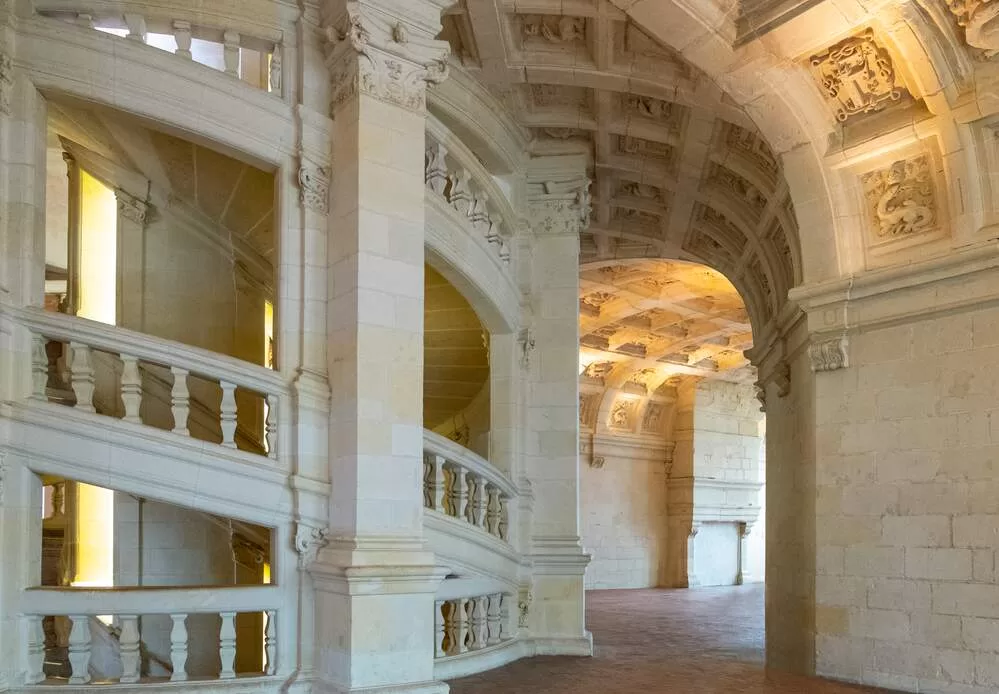Mastercraft
The Art of Luxury Homebuilding™
From Functional Necessity to an Architectural Marvel Ahead of Its Time

Leonardo da Vinci’s Double Helix Staircase at Château de Chambord:
No discussion about the evolution of staircases in architecture can be considered comprehensive without giving due recognition to Leonardo da Vinci’s Double Helix Staircase at Château de Chambord. This architectural marvel stands as a pivotal point in the history of staircases, exemplifying the ingenious fusion of art and functionality that characterizes the Renaissance era.
The Château de Chambord, nestled in the heart of the Loire Valley in France, is a testament to the grandeur and innovation of the Renaissance era. Beyond its intricate architecture and lush surroundings, one of the most remarkable features of this historic château is the double helix staircase, often attributed to the genius of Leonardo da Vinci. This architectural marvel is not only a functional element but also a symbolic representation of da Vinci’s ingenuity and the artistic spirit of the Renaissance.

A Masterpiece of Symmetry and Design
Built between 1519 and 1539, Château de Chambord was initially commissioned by King Francis I of France as a hunting lodge. The château’s design incorporates elements of French medieval architecture and Italian Renaissance aesthetics, resulting in a unique blend of styles. However, one of the most intriguing aspects of Chambord’s design is the double helix staircase that graces its core.
The double helix staircase consists of two intertwined spiral staircases that wind around a central column. The staircases ascend in opposite directions, allowing people to ascend and descend simultaneously without crossing paths. This ingenious design not only serves the practical purpose of optimizing traffic flow but also showcases da Vinci’s fascination with symmetry and proportion.
Da Vinci’s Influence
While the exact extent of Leonardo da Vinci’s involvement in the design of the double helix staircase remains a subject of debate among historians, there is a strong consensus that his influence played a significant role in shaping its form. Da Vinci was known for his exploration of geometry, proportion, and the mechanics of movement. His study of spirals and helices, evident in his various sketches and notebooks, likely inspired the unique design of the staircase at Château de Chambord.
The double helix design is a prime example of da Vinci’s fascination with the interplay between art and science. It seamlessly marries aesthetics with functionality, resulting in a staircase that not only captivates the eye but also provides an efficient means of traversal within the château.
Symbolism and Interpretation
Beyond its functional and aesthetic aspects, the double helix staircase holds symbolic significance. In Renaissance thought, duality and symmetry were often associated with harmony and balance. The intertwined staircases symbolize the interconnectedness of opposites, a concept that resonated with the philosophical and intellectual currents of the time.
Furthermore, the double helix design has been interpreted as a nod to da Vinci’s interest in the Vitruvian Man, a representation of the ideal human proportions. Just as the Vitruvian Man is inscribed in both a circle and a square, the staircase’s dual helices create a visual harmony that reflects da Vinci’s reverence for mathematical beauty.

Preserving a Legacy
The double helix staircase at Château de Chambord has undergone various renovations and restorations over the centuries, and its significance has only grown with time. Visitors from around the world are drawn to this architectural gem, marveling at its spiral intricacies and the genius that birthed it.
In recognition of its historical and cultural importance, the staircase was designated a UNESCO World Heritage site in 1981 as part of the larger Château de Chambord complex. The designation underscores the staircase’s role as a symbol of human creativity and innovation, standing as a testament to the marriage of art, science, and architecture.
Legacy and Inspiration
Leonardo da Vinci’s double helix staircase at Château de Chambord continues to inspire architects, artists, and thinkers alike. Its seamless integration of form and function, its representation of harmony, and its connection to da Vinci’s legacy all contribute to its enduring appeal.
As we stand in awe of this architectural masterpiece, we are reminded that the Château de Chambord’s double helix staircase is more than just a physical structure; it embodies the spirit of the Renaissance, a period marked by the pursuit of knowledge, the celebration of beauty, and the boundless potential of human creativity.
The Evolution of Staircases in Architecture:
From Functional Necessity to Design Masterpiece
Staircases are a ubiquitous feature in architecture, serving as both functional pathways between different levels and as artistic elements that enhance the aesthetic appeal of a space. Over the centuries, the design and purpose of staircases have evolved significantly, reflecting changes in architectural styles, construction techniques, and societal values. In this exploration of the history of staircases in architecture, we’ll journey through time to uncover the fascinating evolution of these structures from their humble beginnings to their status as design masterpieces.
Ancient Origins and Utility
The concept of the staircase dates to ancient civilizations, where rudimentary stepped structures were essential for accessing multi-level buildings.
The earliest known staircases can be traced to the ziggurats of Mesopotamia and the pyramids of Egypt, which featured steep and narrow steps that were primarily functional, designed to facilitate movement rather than impress visually.
Ancient Greek and Roman architecture marked a significant shift in staircase design. The Greeks introduced the “peripteral” temple design, which encircled the central chamber with a colonnade and utilized external staircases to connect different levels. The Romans, on the other hand, perfected the use of the arch and vault, allowing for more complex and grand staircase designs, such as the monumental staircases in the Colosseum and the Baths of Caracalla.
Medieval and Renaissance Innovation
During the medieval period, staircase design became more intricate, but the focus remained largely on utility rather than aesthetics. Spiral staircases became popular in medieval castles and cathedrals due to their space-saving nature. These narrow, winding staircases often had uneven steps and were built clockwise to give defenders an advantage against potential invaders who were usually right-handed.
The Renaissance marked a turning point in architectural history, and staircases began to be seen as more than just functional elements. Architects like Leonardo da Vinci and Filippo Brunelleschi started integrating mathematical principles into their designs, resulting in staircases with more harmonious proportions. The Medici Palace in Florence featured the revolutionary “double helix” staircase designed by Giorgio Vasari, which allowed people to ascend and descend without crossing paths.
Baroque Extravagance and Rococo Elegance
The Baroque period brought about a sense of drama and opulence in architecture, and staircases became an opportunity for architects to showcase their creativity. Elaborate balustrades, ornate railings, and intricate detailing characterized Baroque staircases. The Palace of Versailles boasts the stunning Ambassador’s Staircase, a grand example of this era, featuring a double-revolution design adorned with gilded sculptures and lavish decorations.
The Rococo style that followed further embraced ornamentation and asymmetry. Rococo staircases, exemplified by the works of architect Balthasar Neumann, featured graceful curves, delicate carvings, and pastel colors. The Würzburg Residence in Germany is a prime example of Neumann’s Rococo staircase design, embodying the playful and extravagant spirit of the era.
Neoclassical Symmetry and Industrial Revolution
As architectural tastes shifted towards Neoclassicism in the 18th century, staircases returned to a more symmetrical and balanced style inspired by classical antiquity. The focus was on clean lines, proportion, and a sense of order. This period also saw the rise of the “cantilevered” staircase, where steps were supported by the wall, eliminating the need for visible supporting structures, and creating an illusion of floating steps.
The Industrial Revolution brought about technological advancements that influenced staircase construction. Iron and steel became widely available, allowing architects to design larger and more open staircases. The Eiffel Tower, completed in 1889, features an intricate iron staircase that not only serves as a functional route but also as an architectural marvel.
Modernism and Beyond
The 20th century witnessed a departure from traditional styles as modernist architects embraced simplicity, minimalism, and functionality. Staircases became more integrated into the overall design of buildings, often as sleek and unobtrusive elements. Le Corbusier’s Villa Savoye is a prime example of this approach, featuring a spiral staircase that blends seamlessly with the building’s geometric design.
The advent of reinforced concrete allowed for greater experimentation in staircase design. Architects like Frank Lloyd Wright used concrete to create cantilevered and spiral staircases that defied conventional structural limitations. The Solomon R. Guggenheim Museum in New York City showcases Wright’s innovative spiral staircase that not only facilitates movement but also serves as an integral part of the museum’s interior.
Contemporary Staircase Innovation
Contemporary architecture continues to push the boundaries of staircase design. Advancements in materials, engineering, and digital design tools have opened new possibilities for architects. Floating staircases, which create the illusion of steps suspended in air, have gained popularity, enabled by hidden structural supports and transparent materials.
Staircases are now designed to be more than just functional connectors; they are often sculptural artworks. The Apple Store on Fifth Avenue in New York City features a glass spiral staircase that serves as a focal point, drawing visitors into the store while providing a sense of elegance and modernity.
Sustainability and Future Trends
In recent years, sustainability has become a driving force in architecture, and staircases are no exception. Designers are incorporating energy-efficient materials, optimizing natural lighting, and utilizing renewable resources to create eco-friendly staircases. Vertical gardens and greenery are being integrated into staircase designs, promoting biophilia and improving indoor air quality.
The future of staircase design holds exciting possibilities. With advancements in 3D printing, parametric design, and materials science, architects can envision structures that were once thought impossible. Floating, transparent, and even kinetic staircases could become more common, creating interactive and dynamic architectural elements.
Conclusion
The history of staircases in architecture is a captivating journey through time, revealing how these once-primitive structures have evolved into intricate works of art and engineering marvels. From their humble beginnings in ancient civilizations to their present status as design masterpieces, staircases have mirrored the shifts in architectural styles, technological innovations, and societal values. As we continue to push the boundaries of design and construction, one can only imagine the awe-inspiring staircases that will grace the buildings of the future, seamlessly blending form, and function in ways we have yet to imagine.
Ronin Development Editorial™
Contact Ronin today.
